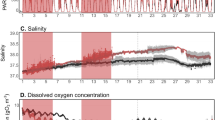Abstract
Short-term changes of the benthic primary production on a tidal sandflat were investigated during low tide and correlated with fluctuations in environmental parameters (light, temperature, salinity and pH) and the possible causal relations were tested in laboratory experiments. There was an almost linear relationship between temperature and photosynthetic rate up to the optimum temperature (20°C in May and 30°C in September). Maximum photosyn-thesis occurred at salinities between 15 and 30‰ S and decreased to 37% at a salinity of 50‰ S. Increase in temperature (18.7° to 22.6°C in May, 8.2° to 18.3°C in September) correlated with photosynthesis during the first h of the low tide period (in May and September), whereas increased salinity (30 to 50‰ S in May and 30 to 48‰ S in September) and possibly also high pH values (up to pH 9.3) correlated negatively with photosynthetic rate during the last part of the period.
Similar content being viewed by others
Literature Cited
Admiraal, W.: Influence of light and temperature on the growth rate of estuarine benthic diatoms in culture. Mar. Biol. 39, 1–9 (1977)
Cadée, G. C. and J. Hegemann: Primary production of the benthic microflora living on tidal flats in the Dutch Wadden Sea. Neth. J. Sea Res. 8, 260–291 (1974)
Colijn, F. and G. van Buurt: Influence of light and temperature on the photosynthetic rate of marine benthic diatoms. Mar. Biol. 31, 209–214 (1975)
Fenchel, T. and B. J. Straarup: Vertical distribution of photosynthetic pigments and the penetration of light in marine sediments. Oikos 22, 172–182 (1971)
Gargas, E. and I. Hare: User manual for estimating the daily phytoplankton production measured in incubator. Contribution from the Water Quality Institute, No. 2, p 75 1976
Gavis, J. and J. F. Ferguson: Kinetics of carbon dioxide uptake by phytoplankton at high pH. Limnol. Oceanogr. 20, 211–221 (1975)
Gnaiger, E., G. Gluth and W. Weiser: pH fluctuations in an intertidal beach in Bermuda. Limnol. Oceanogr. 23, 851–857 (1978)
Gomoiu, M. T.: Some quantitative data on light penetration in sediments. Helgol. wiss. Meeresunters. 15, 120–127 (1967)
Hopkins, J. T.: A study of the diatom of the Ouse estuary Sussex 1. The movement of the mudflat diatoms in response to some chemical and physical changes. J. mar. biol. Assoc. U.K. 43, 653–663 (1963)
Jakobsen, B.: Morfologiske og hydrografiske undersøgelser af flod og ebbeskår i tidevandsrender. Medd. Skalling Lab. XXII, 119–141 (1969)
Jakobsen, N. K.: Landskabsreformerne. Medd. Skalling Lab. XXII, 3–23 (1969)
Kühl, H.: Über die Schwankungen der abiotischen Faktoren in der Elbmündung bei Cuxhaven. Helgol. wiss. Meeresunters. 10, 203–216 (1964)
Lorenzen, C. J.: Determination of chlorophyll and pheopigments: spectrophotometric equations. Limnol. Oceanogr. 12, 343–346 (1967)
Marshall, N., C. A. Oviatt and D. M. Skauen: Productivity of the benthic microflora of shoal estuarine environments in southern New England. Int. Revue ges. Hydrobiol. 56, 947–956 (1971)
Revsbech, N. P., J. Sørensen, T. H. Blackburn and J. P. Lomholt: Distribution of oxygen in marine sediments measured with microelectrodes. Limnol Oceanogr. 25, 403–411 (1980)
Revsbech, N. P., B. B. Jørgensen and O. Brix: Primary production of microalgae in sediments measured by oxygen microprofile, HC14O -3 fixation, and oxygen exchange methods. Limnol. Oceanogr. 26, 717–730 (1981)
Salonen, K.: Rapid and precise determination of total inorganic carbon and some gases in aqueous solutions. Water Res. 15, 403–406 (1981)
Smith, L. W.: Combustion and liquid scintillation determination of carbon-14 in biological samples. Anal. Biochem. 29, 225–229 (1969)
Talling, J. F.: Photosynthetic characteristics of some freshwater plankton diatoms in relation to underwater radiation. New Phytol. 56, 1–50 (1957)
Talling, J. F.: The depletion of carbon dioxide from lake water by phytoplankton. J. Ecol. 64, 79–121 (1976)
Taylor, W. R.: Light and photosynthesis in intertidal benthic diatoms. Helgoländer wiss. Meeresunters. 10, 29–37 (1964)
Thomas, R. C.: Ion-sensitive intracellular microelectrodes, how to make and use them. 110 pp. Ed. by J. E. Treherne and P. H. Rubery New York: Academic Press 1978
Wieser, W. J. Ott, F. Schiemer and E. Gnaiger: An ecophysiological study of some meiofauna species inhabiting an sandy beach at Bermuda. Mar. Biol. 26, 235–248 (1974)
Williams, R. B.: Division rates of salt marsh diatoms in relation to salinity and cell size. Ecology 45, 877–880 (1964)
Wolff, W. J.: Flora and vegetation of the Wadden Sea. Final report of the section “Marine Botany” of the Wadden Sea working group. Report 3 of the Wadden Sea working group. Strichting Veth tot Steun aan Waddenonderzoek, Leiden, p 206 1979
Author information
Authors and Affiliations
Additional information
Communicated by T. Fenchel, Aarhus
Rights and permissions
About this article
Cite this article
Rasmussen, M.B., Henriksen, K. & Jensen, A. Possible causes of temporal fluctuations in primary production of the microphytobenthos in the Danish Wadden Sea. Mar. Biol. 73, 109–114 (1983). https://doi.org/10.1007/BF00406878
Accepted:
Issue Date:
DOI: https://doi.org/10.1007/BF00406878




